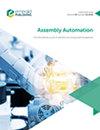基于制造难度系数和遗传算法的关联公差优化方法
IF 1.7
4区 计算机科学
Q3 AUTOMATION & CONTROL SYSTEMS
引用次数: 0
摘要
目的利用遗传算法建立一种基于制造难度计算的公差优化方法。本文是作者对并行工程领域协同最优公差分配方法的研究成果之一。设计/方法/方法本研究介绍了所提出的遗传算法建模。该遗传算法的目标函数是在考虑难度系数的功能需求公差方程约束下使总成本最小化。制造难度计算是基于研究和分析设计或工艺可靠性的工具,如失效模式、影响和临界性分析(FMECA)和石川图。该方法基于难度系数计算和GA优化方法[使用难度系数计算的遗传算法优化(GADCC)],已应用于文献中的机械装配,并与先前的公差值和计算总成本的方法进行了比较。总成本是制造成本和质量损失的总和。所提出的方法是经济和有效的,导致促进制造困难的尺寸,通过增加其公差和减少装配的缺陷零件的比率。这种新的最优公差分配方法的创新之处在于将遗传算法与制造难度结合起来。结合FMECA工具和Ishikawa图计算零件尺寸难度,对比研究表明GADCC优化方法的优越性。结果导致获得最佳公差,使总成本最小化,并尊重功能,质量和制造要求。本文章由计算机程序翻译,如有差异,请以英文原文为准。
Associated tolerance optimization approach using manufacturing difficulty coefficients and genetic algorithm
Purpose
The purpose of this paper is to establish a tolerance optimization method based on manufacturing difficulty computation using the genetic algorithm (GA) method. This proposal is among the authors’ perspectives of accomplished previous research work to cooperative optimal tolerance allocation approach for concurrent engineering area.
Design/methodology/approach
This study introduces the proposed GA modeling. The objective function of the proposed GA is to minimize total cost constrained by the equation of functional requirements tolerances considering difficulty coefficients. The manufacturing difficulty computation is based on tools for the study and analysis of reliability of the design or the process, as the failure mode, effects and criticality analysis (FMECA) and Ishikawa diagram.
Findings
The proposed approach, based on difficulty coefficient computation and GA optimization method [genetic algorithm optimization using difficulty coefficient computation (GADCC)], has been applied to mechanical assembly taken from the literature and compared to previous methods regarding tolerance values and computed total cost. The total cost is the summation of manufacturing cost and quality loss. The proposed approach is economic and efficient that leads to facilitate the manufacturing of difficult dimensions by increasing their tolerances and reducing the rate of defect parts of the assembly.
Originality/value
The originality of this new optimal tolerance allocation method is to make a marriage between GA and manufacturing difficulty. The computation of part dimensions difficulty is based on incorporating FMECA tool and Ishikawa diagram This comparative study highlights the benefits of the proposed GADCC optimization method. The results lead to obtain optimal tolerances that minimize the total cost and respect the functional, quality and manufacturing requirements.
求助全文
通过发布文献求助,成功后即可免费获取论文全文。
去求助
来源期刊

Assembly Automation
工程技术-工程:制造
CiteScore
4.30
自引率
14.30%
发文量
51
审稿时长
3.3 months
期刊介绍:
Assembly Automation publishes peer reviewed research articles, technology reviews and specially commissioned case studies. Each issue includes high quality content covering all aspects of assembly technology and automation, and reflecting the most interesting and strategically important research and development activities from around the world. Because of this, readers can stay at the very forefront of industry developments.
All research articles undergo rigorous double-blind peer review, and the journal’s policy of not publishing work that has only been tested in simulation means that only the very best and most practical research articles are included. This ensures that the material that is published has real relevance and value for commercial manufacturing and research organizations.
 求助内容:
求助内容: 应助结果提醒方式:
应助结果提醒方式:


